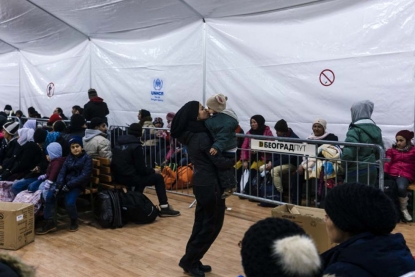Exodus under the Balkan snow
Miratovac, Serbia, January 28, 2016 -- With the cold and snow that descend on the Balkans in the winter, the number of refugees trekking the so-called Balkan migrant route has dwindled from the sea of humanity that made the journey each day in the summer and autumn.
But they are still coming, walking on foot through the freezing cold and snow.
 (AFP / Dimitar Dilkoff)
(AFP / Dimitar Dilkoff)There is about a thousand to two thousand people who come through now, down from the tens of thousands who were here daily when it was warmer.
Gone are the Pakistanis, the Iranians and others. Only the Syrians, the Iraqis and the Afghans remain. They are the only ones -- people from “conflict zones” -- that the Macedonian authorities have been allowing since the end of November to cross through their territory on their way to western Europe.
They are also the most desperate, those who feel they have no choice but to walk through snowstorms -- some of them have never even seen snow -- as temperatures fall to -15 Celsius.
 (AFP / Dimitar Dilkoff)
(AFP / Dimitar Dilkoff)I began to cover the migrant crisis in the Balkans last June and did a number of assignments in Serbia and Macedonia. I knew that with the coming of winter, which is usually quite cold in this region, the situation for these refugees trying to reach Western Europe will become more and more difficult. So as soon as the temperatures dropped and the snow started falling, I proposed to my bosses in Paris that I spend a week on the scene, to see what’s going on. They agreed.
I took these images in the countryside around the Serbian village of Miratovac, near the border with Macedonia. The refugees cross Macedonia by train from the Greek border. The migrants arrive about four or five kilometers from the Serbian border, which they have to walk on foot. I know the hours of the trains, so I know about what time each day the refugees will be appearing in the fields.
 (AFP / Dimitar Dilkoff)
(AFP / Dimitar Dilkoff)Each time they appear, it’s heartbreaking. Again, some of these people have never seen snow, have never lived through a cold winter. The walk across the frozen fields is challenging to say the least. The refugees are exhausted. The children cry.
 (AFP / Dimitar Dilkoff)
(AFP / Dimitar Dilkoff)The first day, it was just me and my colleague from Reuters Marko Djurica. Frankly, I wasn’t very happy with the photos that I took -- I always turn quite sceptical when I see my work -- but the images were widely published in international media, so other journalists began trickling in and soon there was a bunch of us.
The first thing that the refugees have to do is to register with the Serbian authorities. then they are allowed to continue in the direction of Croatia and Slovenia whose borders are still open, unlike Hungary.
 (AFP / Dimitar Dilkoff)
(AFP / Dimitar Dilkoff)They register in a camp in the town of Presevo. Non-governmental organizations have put in place a system where the women, children and the elderly or those with difficulty walking, are taken there by van from the border. But others have to walk the seven kilometers.
 (AFP / Dimitar Dilkoff)
(AFP / Dimitar Dilkoff)Luckily the refugees don’t have to spend the night outside. The camps that were put in place in Presevo last summer, when tens of thousands were passing through every day, have enough room to take everyone in. The locals also help a bit. It may not be super comfortable, but at least noone is dying of cold and hunger.
 (AFP / Dimitar Dilkoff)
(AFP / Dimitar Dilkoff)This is not the first humanitarian crisis that I have covered in the region. I covered the Kosovo war from 1998 to 1999, when there were also lots of desperate refugees. But their numbers were miniscule compared with what we have seen over the past several months. At the moment it’s worse. So much worse.
Dimitar Dilkoff is an AFP photographer based in Sofia. This blog was written with Roland de Courson and translated by Yana Dlugy in Paris.
 (AFP / Dimitar Dilkoff)
(AFP / Dimitar Dilkoff)

